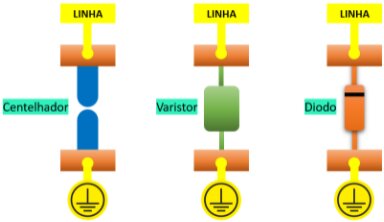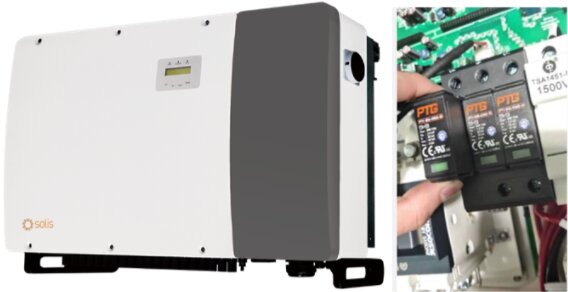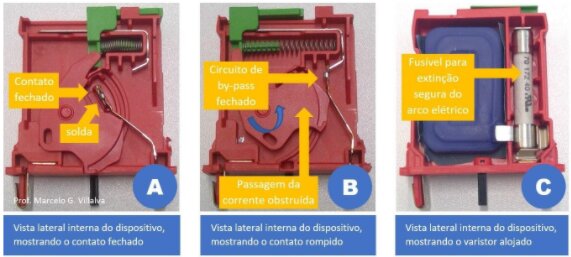During the webinar “Stringbox: standards and good practices”, held on November 10, addressed, among other topics, the importance of the DPS (surge protective device) in photovoltaic installations. The webinar presented had a strong focus on the importance of stringbox external and one of the aspects addressed was the ease it offers for maintaining the surge protector, as opposed to the internal DPS found in some inverters. An important conclusion is that the presence of an internal DPS in the photovoltaic inverter is beneficial, but we can benefit from more security when there is an external DPS, as long as it is coordinated with the internal one. The presentation, as well as the article “Stringbox with DPS is necessary or not? What does NBR 16690 say?” highlighted the need for DPS maintenance when the device reaches the end of its useful life. A doubt, which still affects many market professionals, ended up being raised: how do you know if the time has come to replace the DPS?
Types of DPS
Before answering the question, let's remember that there are three types or classes of surge protectors that we can use in photovoltaic and electrical installations in general: I, II and III. Surge protectors are classified according to performance test methods, in accordance with the standard NBR IEC 61643-1 – Low voltage surge protection devices. Class I devices are recommended for locations with high exposure to direct electromagnetic surges, such as input lines to locations protected by SPDA (atmospheric discharge protection system). Class II and III devices are suitable for pulses of shorter duration and are recommended for places with less exposure, normally inside installations or places that will indirectly receive the effects of atmospheric discharges. Class I surge protectors are normally of the “voltage switching” type, as defined in NBR IEC 61643-1. These devices exhibit high impedance (open circuit) when no surge is present and are quickly switched to the low impedance (closed circuit) state in response to a surge. This category includes protectors based on spark gaps and other “short-circuit” switching devices, which have an open or closed behavior. Class II and III protectors are of the “voltage limiter” type, also according to the terminology found in the standard. These devices exhibit high impedance (open circuit) when no surge is present, but continually reduce impedance as the electromagnetic surge increases. These devices can be based on varistors (class II) or zener diodes (class III), which gradually close the bypass circuit to ground according to the intensity of the surge present at its terminals.

Class II and III DPS are used as protection complements in locations already served by a class I DPS. In installations in general, it is very common to use only class II DPS in low exposure locations, with distances of maximum 10 meters from the equipment to be protected. Class III DPS is always used close to the equipment to be protected. It is the one that offers the lowest degree of protection, being used in situations of very low exposure or in coordination with devices from other classes.
Varistor: the active element of class II DPS
DPS class II is adopted in all photovoltaic systems, both in the DC string-box and in the AC connection panel. Its function is to mainly protect the inverter, which is an expensive and sensitive component of the photovoltaic system. The DPS can also be found inside the inverter itself – in this case, it can be coordinated with an external DPS, which increases protection and makes maintenance easier, as we mentioned at the beginning of the article.

The active element of the class II DPS is the varistor, which is an electronic component that has a variable impedance depending on the voltage level found at its terminals. The varistor appears practically as an open circuit when the voltage across it is small, but gradually converts to a closed circuit as the voltage increases. This behavior makes it a voltage limiting device, capable of limiting overvoltages and diverting transient electrical currents present in electrical installations.

DPS Status Check
Now that we know what's inside the Class II DPS, let's answer the initial question of the article: how do you know if the DPS needs to be replaced? It is difficult to know when and how the DPS will act and how quickly it will wear out, as this depends on the frequency and intensity of surges caused by lightning strikes or other causes (such as electrical power distribution network maneuvers) in the location where the device is employed. After successive actuations, the varistor wears out and needs to be replaced, when its impedance and voltage limiting capacity are already reduced. A varistor-based SPD can conduct between 10 and 20 times its rated current and one or two times its maximum current [2]. In commercial protectors, the varistor is located in a removable module, which can be replaced, as shown in the figure below. A status window indicates the status of the device. A green signal means that the device is still within its validity period, while a red signal indicates that the DPS no longer offers any protection and needs to have its varistor replaced.

The figure below illustrates the operation of the DPS status signaling device. More than signaling the status, the mechanism shown in the figure has the function of isolating the varistor from the electrical installation when it reaches the end of its useful life, preventing it from overheating and causing a fire. The operating principle of the system is to open a contact by melting a solder point. When the varistor has its impedance reduced, a current begins to circulate through the device even in the absence of voltage surges. When the current intensity reaches a critical level, the contact opens due to the pressure of a spring, isolating the device and simultaneously causing the position of the signal flag to change (green element in the figure below).

One detail draws attention in the figure above: the presence of a fuse for safe electric arc extinction next to the varistor. This element is not found in all surge protectors available on the market, but its presence is desirable to prevent the formation of an electric arc when the contact is opened. This feature provides additional protection for installations employing Class II DPS.
Learn more
You may also be interested in these articles published on Solar Channel:
- DPS: The airbag of photovoltaic systems
- What is DPS and how is it used in photovoltaic systems
- Stringbox with DPS is necessary or not? What does NBR 16690 say?
- DPS with DEHN SCI protection and disconnection technology for PV systems
- Assessment of DPS installed in photovoltaic inverters
- When to use a Class I DPS
- How lightning affects photovoltaic systems
- Understand the basic specifications of string box components
- What is DPS and how is it used in photovoltaic systems
References
- [1] NBR IEC 61643-1 – Low voltage surge protection devices – Part I
- [2] DPS Specification – Obo Bettermann Bulletin – Eng. Sérgio Roberto Santos
- [3] Surge Protection Devices (DPS) – The Electrical Sector – October, 2012 – Eng. Sérgio Roberto Santos

















One Response
Thank you very much for this article, it is very enlightening and also highlights the importance of its use and its ability to protect circuits and their users and it also becomes very advantageous due to all its technical characteristics and, always observed its protections when prospecting electrical projects.